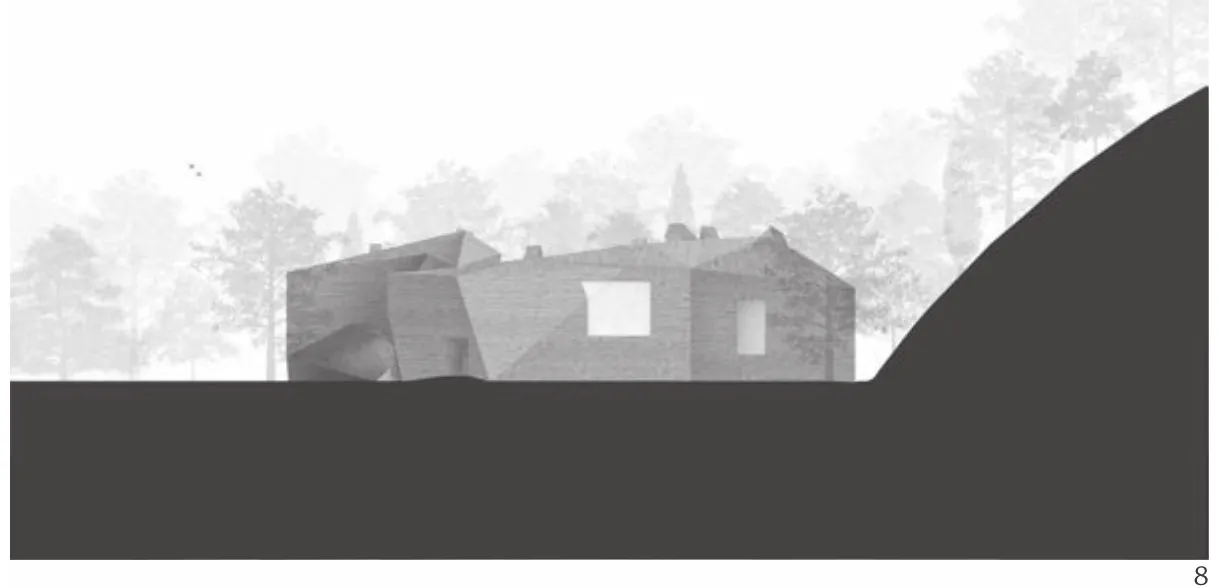肖峰艺术馆,杭州,中国
2018-10-27建筑设计标准营造
建筑设计:标准营造
这座展示画家肖峰作品的艺术馆位于著名的西湖以南数公里处,在杭州大慈山脚下。建筑的平面从一座中心园林出发,以强烈的内向性体现出中国传统文人园林的关键特征。布局自然地顺应场地边界,在展览空间中形成了线性的流线。沿着外缘蜿蜒的展厅空间,一连串凸起的矩形房间可供人向内欣赏园景,有些地方还能看到后面的群山。建筑的屋顶设计在景观中营造出一种层次感与动势。有机的体块从正面缓缓升起,形成了园林的入口通道,而建筑的主入口掩映在树木与竹林之后。这样,艺术馆就成了景观的一部分,并使置身于大自然中的感受得以升华。□(尚晋 译)
The museum for the work of the painter XIAO Feng is located a few kilometres to the southern side of the famous West Lake, at the foot of Daci Mountain in Hangzhou. The plan of the building is based on the idea of a central garden, with a strong introversive sense reflecting a character that is key to traditional Chinese intellectual gardens. The layout naturally follows the site boundary and forms a linear circulation route through the exhibition spaces. Alongside the winding gallery spaces on the outside edge, a series of projecting rectangular rooms looking inside provide views of the garden and, in some cases, also views towards the mountains at the back. The roof of the building was designed to generate a sense of layering and movement in the landscape. The organic volume rises gradually at the front to form an entryway to the garden, where the main entrance of the building is hidden behind trees and bamboo groves. Thus the museum becomes a part of the landscape and enhances natural feelings. □
1 草图/Sketch
2 模型/Model




1-入口大厅/Entrance hall
2-第二入口厅/Secondary entrance foyer
(1)speaking to journalists after talks with DPRK envoys,Richardson(former U.SAmbassador of the UN)said the consultations werepositiveand constructiveand helped easethetension concerning the DPRK’s nuclear program.(Beijing Review January 23,2003 Vol 46)
5.5 鼓励企业提高科研投入 通过科研项目引导企业提升自主创新能力,通过税收、中小企业研发基金等政策增加企业自身科研投入。组织工业领域,甚至军工领域从材料、工艺、设计研究单位、转制企业等方面,共同针对关键技术持续集中攻关,并形成市场化供应能力。
2-3号厅/Hall 3
7.8 立面/Elevations
9.10 剖面/Sections
试验设计采用室内盆栽试验,试验设置6个不同处理:未添加化学修复剂(CK)、2%骨炭(A)、2%活性炭(B)、2%磷矿粉(C)、2%土壤修复剂Ⅰ(D)和2%土壤修复剂Ⅱ(E)。每个处理4次重复。土壤培养容器为1 500mL塑料盆,每盆置入1 000g自制混合土样,按照试验设计的比例称取相应的化学修复剂(各20g)加到土壤中,并混合均匀,恒温恒湿(20℃-22℃,湿度65%)。在每个塑料盆中分别种植已筛选出的富集乡土植物油菜、马铃薯、狼尾草、小麦、刺儿菜、巴天酸模,在户外栽培100d,测定土壤中重金属含量,评价试验用的修复剂对重金属污染土壤的修复效果。
3-接待处/Reception
5-仓库/Storage
6-5号厅/Hall 5
表2表明,不同存续周期区间内少数民族传统体育微信公众号的数量存在非常显著性差异(P<0.01),存续周期0~5个月以内的占样本总量的50.7%,说明少数民族传统体育微信公众号存在开通之后疏于管理、未能及时推送消息的管理缺陷。
7-新风/Air renewal
8-安保监控室/Security monitoring room
9-弱电室/Low voltage room
10-强电室/High voltage room
1-2号厅/Hall 2
微课展示的内容生动形象,但是仍需要注意一些问题,比如:一是微课时间较短,内容应该呈现课程重点,并不是要将整节课程减短;二是在高职院校的德育课堂上展示的内容不能一遍过,而应该同时用于学生自主学习、提前预习、课后复习;最后是微课设计内容要根据高职学生的情况及其学习特点进行制作,播放的内容要切合实际、贴近生活,将教材内容和实际生活相结合,引起学生的注意,激发学生学习德育课程的兴趣,展现微课在德育课堂的教学效果。
海德格尔自身的言说也是如此。海德格尔那里的语言言说了世界,语言让世界显现出来。在《旧约全书》和《新约全书》中,上帝说要有光,于是便有光,上帝创造世界,是通过他的语言、道开启出来的。但海德格尔所讲的语言并不是上帝的话语,更不是上帝的“道”。海德格尔的世界有一个独特的说法:“四元”,即大地、天空、诸神和人(能死者)。语言召唤出天地人神四元。这里探讨的不是发生论或者自然科学上天地人之间的先后关系,而是语言和世界的本源性关系。语言呼唤天地人神的到来,并不是简单的生产、创造天地,而是将天地人神构成一个整体,将四者以各自本性、本然的面貌和方式纳入一个整体之中共存。
3-4号厅/Hall 4
在不考虑阻尼的情况下,在式(58)中令右边项为零,同时令那么可以得到一个以ω为特征值为特征向量的特征值问题,即
4-5号厅/Hall 5
5-办公室/Offce
复杂地区地震勘探的一个重要问题是噪声问题,对复杂地区的地震勘探而言其噪声类型繁多,严重影响资料品质,因此,如何压制干扰波是复杂区地震勘探的主要问题之一。山地地震勘探中的干扰大致可分为环境干扰和激发后的半生与次生干扰2大类。因此,要进行波场调整,并针对资料影响较大的干扰设计组合图形,压制干扰,提高资料的信噪比。根据干扰波的特征,把沿测线方向最强的一束干扰波作为主测线组合检波的压制对象或组合检波纵向组合基距的考滤对象;把垂直测线方向最强的一束干扰波作为联络测线组合检波的压制对象或组合检波横向组合基距的考滤对象;还可以通过适当的提高地震仪器低截滤波参数或使用高频检波器进行压制。
6-VIP厅/VIP hall
3 总平面/Roof site plans
4 首层平面/Ground floor plan
5.6 平面/Plans
4-垃圾堆放/Garbage store
SAEW-2:ACC:(60.0±1.9)mg/L,p H:6.45±0.24,下述简称:SAEW(60)。







11-13 外观概念/Exterior images
14.15 庭院概念/Courtyard images



16 内景概念/Interior image
评论
陈忱:肖峰艺术馆位于杭州西湖南畔大慈山脚下,掩映在一片密林中,建筑师试图以一个环状线性的展览空间围合出一个具有东方韵味的庭院。狭长的场地被陡峻的山体包围,在这样致密的植被、精致的风景中,这个近4000m2的建筑物呈现了一个不寻常的姿态——并非最大化向外的视野,而是着意塑造一个内向的围合。建筑师对于视野与光线的控制几近严苛:只有4处景框允许望向山林;除了7个具有特定朝向的窗,整个建筑几乎完全封闭,而屋面6个北向的凸窗限制室内在特定的时间产生特定的光影效果。与在优美的自然风景地段常见的轻盈而通透的建筑物不同,艺术馆粗糙的木纹混凝土以及体型的切削使它看起来格外厚重与封闭。外立面几乎没有一扇窗户,仅在庭院入口处体型微微上掀处,才能窥见内部别有洞天植物茂密的庭院。
整个建筑体量呈现一种无预设的有机状态:这是一部由内而外的构筑物,空间大于形式,而体验又大于空间。可以看到建筑师对于形式本身的放松:看似随意的体形,实际上来源于对参观动线、体验序列的物化包裹,近100m的展览动线组成了室内空间的全部。建筑师想要呈现的空间体验可被理解为一系列的关键剖面以极缓的上下起伏的坡道顺接而成。这些剖面在厚与薄、宽与窄、高与低之间不断变换,空间的收放产生了强烈的张力,让通过本身成为一种令人印象深刻的体验。在7个取景框处,空间得到极致的放大,同时巨大的玻璃将空间进一步向外部的景观中延伸;而一些通道则非常狭窄,配合空间的挤压状态,墙体也更加封闭。整个室内空间没有绝对的动线与房间的分别,各功能空间之间在没有任何隔断的条件下自由流动。容纳了后勤与机电空间的“加厚”墙体,使得主要的展览空间获得了最大程度的自由。
Comment
CHEN Chen:The Xiao Feng Art Museum is located at the foot of Daci Mountain on the south bank of West Lake in Hangzhou, hidden in a dense forest. The architect tries to enclose an Oreintal style courtyard with a circular linear exhibition space. The narrow site is surrounded by steep hills. Within such dense vegetation and exquisite landscape, the nearly 4,000m2building presents an unusual gesture – not maximising the outward view, but deliberately creating an inward enclosure. The architect's control of view and light is almost rigid: only 4 scenery frames are allowed to look to the woods; the entire building is almost completely secluded but for 7 windows with specific orientations,and the 6 north-facing oriels on the roof limitedly produce specific light and shadow effects at specific times. Unlike the lightweight and transparent buildings commonly seen in places with beautiful natural sceneries, the art museum's rough wooden-patterned concrete and the shape make it look particularly thick and enclosed. There is hardly any window on the outer facade, and only at the entrance of the courtyard where the shape is slightly lifted can it be seen that there is a whole flourishing courtyard inside.
The whole building volume presents an unexpected organic state: it is a structure from inside to outside,with space greater than form, and experience greater than space. We can see the architect's relaxation about the form itself: the seemingly arbitrary shape in fact comes from the physical package of the visiting route and the experience sequence. The exhibition route of nearly 100m constitutes the whole interior space. The spatial experience the architect wants to present can be interpreted as a series of key sections connected in order by extremely gentle slopes up and down. These sections are constantly changing between thick and thin, wide and narrow, high and low, and the retractions and releases of the space create a strong tension and make passing itself an impressive experience. At the seven scenery frames, the space is maximised, while the huge glass further extends the space to the outside landscape;some passageways, on the other hand, are very narrow,in combination with a pressing state of space and more enclosed walls. The whole indoor space has no absolute separation between the route and the rooms, and all the functional spaces flow freely without any partition. The"thickened" walls that accommodate both logistics and electromechanical space, give the main exhibition space maximal freedom. (Translated bo CHEN Yuxiao)
